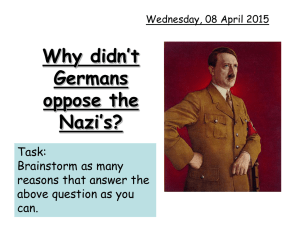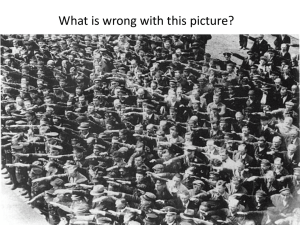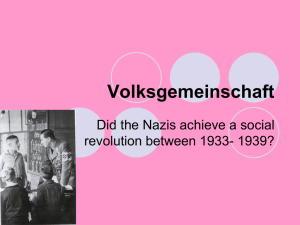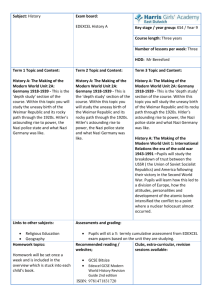Marion Kaplan - The Skirball Department of Hebrew and Judaic
advertisement
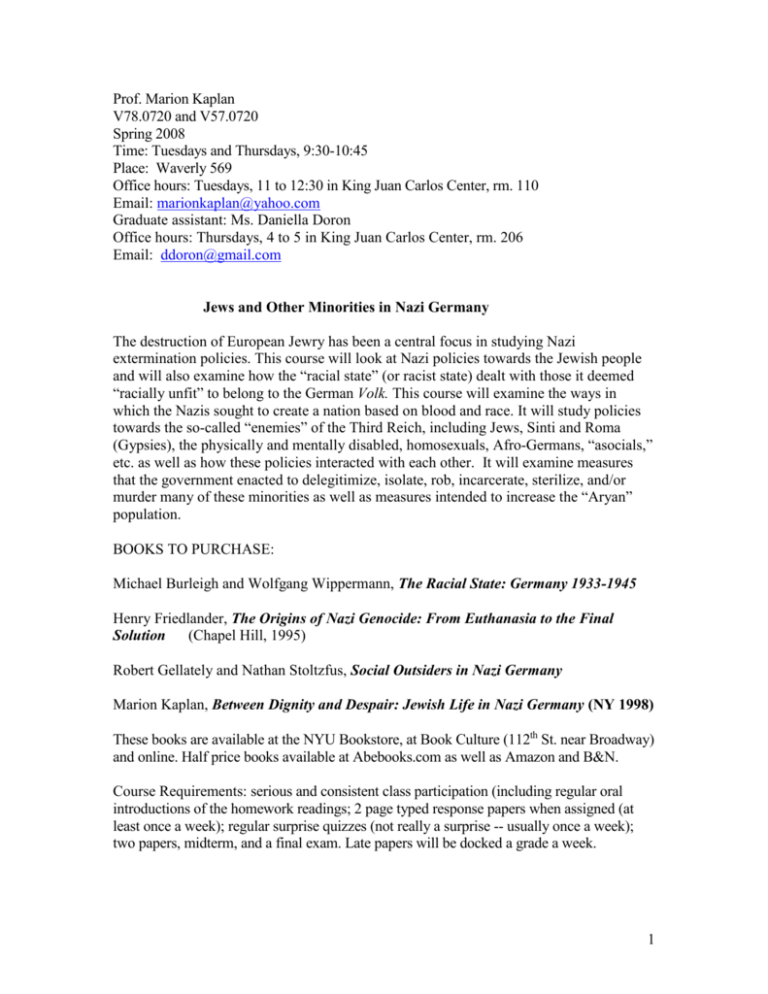
Prof. Marion Kaplan V78.0720 and V57.0720 Spring 2008 Time: Tuesdays and Thursdays, 9:30-10:45 Place: Waverly 569 Office hours: Tuesdays, 11 to 12:30 in King Juan Carlos Center, rm. 110 Email: marionkaplan@yahoo.com Graduate assistant: Ms. Daniella Doron Office hours: Thursdays, 4 to 5 in King Juan Carlos Center, rm. 206 Email: ddoron@gmail.com Jews and Other Minorities in Nazi Germany The destruction of European Jewry has been a central focus in studying Nazi extermination policies. This course will look at Nazi policies towards the Jewish people and will also examine how the “racial state” (or racist state) dealt with those it deemed “racially unfit” to belong to the German Volk. This course will examine the ways in which the Nazis sought to create a nation based on blood and race. It will study policies towards the so-called “enemies” of the Third Reich, including Jews, Sinti and Roma (Gypsies), the physically and mentally disabled, homosexuals, Afro-Germans, “asocials,” etc. as well as how these policies interacted with each other. It will examine measures that the government enacted to delegitimize, isolate, rob, incarcerate, sterilize, and/or murder many of these minorities as well as measures intended to increase the “Aryan” population. BOOKS TO PURCHASE: Michael Burleigh and Wolfgang Wippermann, The Racial State: Germany 1933-1945 Henry Friedlander, The Origins of Nazi Genocide: From Euthanasia to the Final Solution (Chapel Hill, 1995) Robert Gellately and Nathan Stoltzfus, Social Outsiders in Nazi Germany Marion Kaplan, Between Dignity and Despair: Jewish Life in Nazi Germany (NY 1998) These books are available at the NYU Bookstore, at Book Culture (112th St. near Broadway) and online. Half price books available at Abebooks.com as well as Amazon and B&N. Course Requirements: serious and consistent class participation (including regular oral introductions of the homework readings; 2 page typed response papers when assigned (at least once a week); regular surprise quizzes (not really a surprise -- usually once a week); two papers, midterm, and a final exam. Late papers will be docked a grade a week. 1 1. (Jan. 22) INTRODUCTION HISTORICAL BACKGROUND 2. (Jan. 24) Robert Gellately and Nathan Stoltzfus, “Social Outsiders and the Construction of the Community of the People,” in Gellately and Stoltzfus, Social Outsiders in Nazi Germany (pp. 3-19) and Richard Evans, “Social Outsiders in German History: From the Sixteenth Century to 1933,” in Gellately and Stoltzfus, pp. 20-44 3. (Jan. 29) Excerpts from Race and Membership in American History: the Eugenics Movement [blackboard] Recommended: Stefan Kühl, The Nazi Connection: Eugenics, American Racism, and German National Socialism George Fredrickson, Racism: A Short History 4. (Jan. 31) Michael Burleigh and Wolfgang Wippermann, The Racial State, pp. 1-4, 2374 THEORIES OF “WHY?”: PART I 5. (Feb. 5) “When good people do evil: the Milgram experiments revisited,” Yale Alumni Magazine, Jan/Feb. 2007 [blackboard--see Milgram] and “Finding Hope in Knowing the Universal Capacity for Evil,” New York Times, April 3, 2007 [blackboard--see Zimbardo] and Zygmunt Bauman, Modernity and the Holocaust, chaps. 2 and 3 “Modernity, Racism, Extermination” [blackboard] JEWS AND “MIXED MARRIAGES” 6. (Feb. 7) Burleigh, chap. 4, “The persecution of the Jews,” pp. 75-112 7. (Feb. 12) Marion Kaplan, Between Dignity and Despair: Jewish Life in Nazi Germany Intro. and chap. 1-2 (pp. 3-73) Students with last names A-L meet with Ms. Doron in King Juan Carlos Building lobby (51 Wash. Sq. S. next to Judson Church) 8. (Feb. 14) Kaplan, chaps. 3 - 5 (pp. 74-144) 9. (Feb. 19) Kaplan, chaps. 6, 7, 8, and Conc. (pp. 145-237) Recommended: Saul Friedlander, Nazi Germany and the Jews SINTI AND ROMA (GYPSIES) 10. (Feb. 21) Burleigh, 113-128 and 2 Margalit, Germany and its Gypsies, pp. 25-55 [blackboard] Recommended: Gilad Margalit, Germany and its Gypsies: A Post-Auschwitz Ordeal Guenther Lewy, The Nazi Persecution of the Gypsies Donald Kenrick and Grattan Puxon, The Destiny of Europe’s Gypsies 11. (Feb. 26) Sybil Milton, “Gypsies as Social Outsiders in Nazi Germany,” in Gellately and Stoltzfus, pp. 212-232 and Wolfgang Wippermann, “Christine Lehmann and Mazurka Rose: Two ‘Gypsies’ in the Grip of German Bureaucracy, 1933-1960,” in Michael Burleigh, ed., Confronting the Nazi Past: New Debates on Modern German History, pp. 112- 123 [on blackboard] Students with last names M-Z meet with Ms. Doron in KJCC HOMOSEXUALS 12. (Feb. 28) Burleigh, pp. 183-197 Geoffrey Giles, “The Institutionalization of Homosexual Panic in the Third Reich,” in Gellately and Stoltzfus, pp. 233-255 and Stefan Micheler, “Homophobic Propaganda and the Denunciation of Same-Sex-Desiring Men under National Socialism, “The Journal of the History of Sexuality vol. 11, nos. 1-2 (Jan/April 2002) [available online: Project Muse -- go to NYU home, then to “research”] Recommended: Gad Beck, An Underground Life: Memoirs of a Gay Jew in Nazi Berlin John Fout, ed., Homosexuals and Homosexuality in Germany from the Kaiserreich through the Third Reich Claudia Schoppmann, Days of Masquerade: life stories of lesbians during the Third Reich (trans. Allison Brown) (NY, 1996) 13. (March 4) First Reports on Jews, Sinti/Roma, or homosexuals due: be prepared to talk about your report in class (see end of syllabus for requirements) THE PHYSICALLY AND MENTALLY DISABLED 14. (March 6) Henry Friedlander, The Origins of Nazi Genocide, chap. 1, “The Setting” Burleigh, pp.148-167 Students with last names A-L meet with Ms. Doron in KJCC 15. (March 11) Friedlander, chaps. 2-5 16. (March 13) Friedlander, chaps. 6-9 Students with last names M-Z meet with Ms. Doron in KJCC (March 17-22, Spring break) 3 17. (March 25) Midterm 18. (March 27) Friedlander, chaps. 10-14 AFRO-GERMANS 19. (April 1) May Opitz, Katharina Oguntoye and Dagmar Schultz, African and AfroGerman Women in the Weimar Republic and under National Socialism,” in Showing our Colors: Afro-German Women Speak Out,” pp 41-76 [blackboard] and Raffael Scheck, “The Executions of Black Soldiers from the French Army by the Wehrmacht in 1940: The Question of Authorization” [available on blackboard, courtesy of Prof. Scheck] Recommended: Hans Massaquoi, Destined to Witness: Growing up Black in Nazi Germany Clarence Lusane, Hitler’s Black Victims: The Historical Experience of AfroGermans, European Blacks, Africans, and African Americans in the Nazi Era (New York/London, 2003) THE “ASOCIAL” AND “HABITUAL CRIMINAL” 20. (April 3) Burleigh, pp. 48-49, 167-182 Nikolaus Wachsmann, “From Indefinite Confinement to Extermination: “Habitual Criminals” in the Third Reich, “in Gellately and Stoltzfus, pp. 165-191 Students with last names A-L meet with Ms. Doron in KJCC 21. (Apr. 8) Annette Timm, “The Ambivalent Outsider: Prostitution, Promiscuity, and VD Control in Nazi Berlin,” in Gellately and Stoltzfus, pp. 192-211 and Annette Timm, “Sex with a Purpose: Prostitution, Venereal Disease, and Militarized Masculinity in the Third Reich,” The Journal of the History of Sexuality, vol. 11, nos. ½ (Jan/April 2002) [available online: Project Muse] FOREIGN WORKERS 22. (Apr. 10) Burleigh, pp. 295-303 Robert Gellately, “Police Justice, Popular Justice, and Social Outsiders in Nazi Germany: The Example of Polish Foreign Workers,” in Gellately and Stoltzfus, pp. 256-272 and Birthe Kundrus, “Forbidden Company: Romantic Relationships between Germans and Foreigners, 1939-1945,” in Journal of the History of Sexuality - Volume 11, Number 1 and 2, January/April 2002, pp. 201-222 [available online: Project Muse] 23. (Apr. 15) Second Reports due. (HETERO)SEXUALITY AND RACISM 24. (Apr. 17) Nazi Policies towards Women Burleigh, pp. 242-266 4 and Jill Stephenson, “Women, Motherhood and the Family in the Third Reich” in Michael Burleigh, ed., Confronting the Nazi Past: New Debates on Modern German History, pp. 167-182 [on blackboard] 25. (Apr. 22) Nathan Stoltzfus, “The Limits of Policy: Social Protection of Intermarried German Jews in Nazi Germany,” in Gellately and Stoltzfus, pp. 117- 144 and Patricia Szobar, “Telling Sexual Stories in the Nazi Courts of Law: Race Defilement in Germany, 1933-1945,”Journal of the History of Sexuality - Volume 11, Number 1 and 2, January/April 2002, pp. 131-163 [available online: Project Muse] Recommended: Gisela Bock, “Racism and Sexism in Nazi Germany,” in Renate Bridenthal, Atina Grossmann, Marion Kaplan, eds., When Biology became Destiny: Women in Weimar and Nazi Germany (New York, 1984) Czarnowski, Gabriele, “The Value of Marriage for the Volksgemeinschaft: Policies towards Women and Marriage under National Socialism,” in Bessel, ed. Fascist Italy and Nazi Germany (1996) 26. (Apr. 24) “ARYAN” YOUTH (Nazis and Outsiders) Burleigh, 199-241 RACE WAR AGAINST THE SOVIET UNION AND EASTERN PEOPLE 27. (Apr. 29) Christian Streit, “Soviet Prisoners of War in the Hands of the Wehrmacht” in Hannes Heer and Klaus Naumann, eds., War of Extermination: The German Military in World War II (New York/Oxford, 2004) chap. 4 (pp. 80-89) [on blackboard] and Doris Bergen, “Sex, Blood, and Vulnerability: Women Outsiders in German-Occupied Europe,” in Gellately and Stoltzfus, pp. 273-88 Recommended: Omer Bartov, Hitler’s Army: Soldiers, Nazis and War in the Third Reich Bernd Boll and Hans Safrian, “On the Way to Stalingrad: The 6th Army in 194142,” in Heer and Naumann, War of Extermination, chap. 10 (pp. 237-264) [on blackboard] G. Hirschfeld, ed., The Policies of Genocide: Jews and Soviet Prisoners of War in Nazi Germany T. Schulte, The German Army and Nazi Policies in Occupied Russia 28. (May 1) THEORIES OF “WHY?”: PART II Hannes Heer, “How Amorality became Normality: Reflections on the Mentality of German Soldiers on the Eastern Front,” from Heer and Naumann, War of Extermination , chap. 13 (pp. 329-341) [on blackboard] and 5 Christopher Browning, “Holocaust Perpetrators: Ideologues, Managers, Ordinary Men,” (March 6, 2002 lecture at US Holocaust Memorial Museum [available online http://www.ushmm.org/conscience/analysis/details/2002-03-06/browning.pdf ] and Claudia Koonz, The Nazi Conscience, “Racial War at Home” (chap. 10, pp. 253-274) [on blackboard] and review your notes from class # 5 6 WRITING GUIDELINES: Please learn the definition of plagiarism, one of the most serious forms of academic misconduct: “Presenting another’s words or ideas as your own.” Always cite your sources (including books, articles, and web sites) and use quotation marks whenever you use a phrase of more than 3 words in succession from another person’s work. Paraphrasing an idea does not make it your idea. You may use it, but give credit where credit is due. Remember that professors can find websites as easily as students. Plagiarism will result in an F for the course and notification of the deans. WRITING: Write your papers as if you were writing for an English class! Be sure to go over this quick checklist of common writing mistakes before you hand in your papers. Mistakes on your papers will be circled and the numbers below written next to them. 1. Have you paginated? 2. Have you underlined all foreign words and book titles? 3. Does EVERY sentence have a subject and verb? Have you read each sentence aloud to see if it makes sense? 4. Quotations: A short quotation – of fewer than 5 lines—should be enclosed in quotation marks and combined smoothly as part of your own sentence. A longer quotation should be single spaced, indented, have no quotation marks, and be introduced by you. Quotations cannot stand by themselves. 5. Quotations marks: "Quotation marks enclose punctuation." 6. Citations: simple in-text citations come at the end of the sentence, followed by a period (Author, page __). 7. Paragraphs start with a topic sentence, support its ideas, and end with a concluding thought that rounds up the paragraph. Watch out for extraneous ideas that don’t help you build your paragraph. 8. You need "transition" thoughts between paragraphs. They have to follow each other in some logical order. This will be easy if you have outlined your paper logically. 9. Watch how you use tenses! You should refer to historical issues and events in the past tense. Try to keep your writing in the past tense. 10. Do not use contractions (I’m, he’s, we’re). 11. Do not use colloquialisms. 12. Avoid the passive voice. Use it very sparingly. Reread your paper and rewrite 80% of the sentences that use some form of the verb to be (including were or was). Passive verbs can exist in any tense. They may or may not employ an auxiliary verb. Here are some examples: 7 Active Linda expressed anger. Linda drives the car. Passive Linda was angry. The car is driven by Linda. Linda drove the car. The car was driven by Linda. Linda was driving the car. The car was being driven by Linda. Linda has driven the car. The car has been driven by Linda. First BOOK/FILM ASSIGNMENT: Choose a book and film about Jews, Sinti/Roma, or homosexuals (male and/or female) and write a report comparing and contrasting the book and film you have chosen. Your report should: 1) Refer to your class readings where appropriate, situating your book in the context of your readings and our class discussions. Specifically, how did the group in the book you have chosen experience the Nazi years? What did you see as the main points in your book and film? Did they challenge or confirm your other readings? In what ways? 2) Contrast the book and the film. How did the book portray your group’s experiences as compared to the film? You may choose from the recommended readings and films on the syllabus, or on the bibliography on blackboard, or from your own research. Please check with me if you have done the latter. 8 pages, typed and carefully edited keeping all 12 points on the above checklist in mind. Second ASSIGNMENT: You will be given an identity by lottery (Sinti/Roma, Jewish, handicapped, German soldier, etc.) and will be expected to explain how this person fared starting slightly before 1933 but concentrating on Nazi Germany until 1945. You will be asked to read a book, some articles and some life histories about this person or group. 10 pages typed and carefully edited keeping all 12 points on the above checklist in mind. FILMS AT BOBST (AVERY FISHER) JEWS: David, VCA12992; Jacob the Liar, VCA9545; Europa, Europa, VCA5082; Genocide, VCA3718 HOMOSEXUALS: Aimee and Jaguar, VCA12069, DVD 756; Desire, VCA6010; Paragraph 175 FOREIGN WORKERS: A Love in Germany (# in processing) SINTI/ROMA: Porraimos “ARYANS”: Triumph of the Will, VCA264 8 There are other films at Bobst as well. Check the website. If you would like to rent films not available at Bobst, there are also many. Try to find, for example, “Bent” (1997), about homosexuals in Nazi Germany, or “Ehe im Schatten,” about intermarriage with a Jewish spouse (if you can understand German), or “Persecuted and Forgotten: The Gypsies of Auschwitz.” 9


